Bidirectional Chaotic Synchronization Communication of Closed-Loop Mutually Coupled Nano-Lasers
Abstract
1. Introduction
2. Theoretical Model
3. Numerical Results
4. Conclusions
Author Contributions
Funding
Data Availability Statement
Acknowledgments
Conflicts of Interest
References
- Wang, D.; Wang, L.; Li, P.; Zhao, T.; Jia, Z.; Gao, Z.; Guo, Y.; Wang, Y.; Wang, A. Bias Current of Semiconductor Laser: An Unsafe Key for Secure Chaos Communication. Photonics 2019, 6, 59. [Google Scholar] [CrossRef]
- Tang, Y.; Li, Q.; Dong, W.; Hu, M.; Zeng, R. Optical Chaotic Communication Using Correlation Demodulation between Two Synchronized Chaos Lasers. Opt. Commun. 2021, 498, 127232. [Google Scholar] [CrossRef]
- Jiang, N.; Xue, C.; Lv, Y.; Qiu, K. Physically Enhanced Secure Wavelength Division Multiplexing Chaos Communication Using Multimode Semiconductor Lasers. Nonlinear Dyn. 2016, 86, 1937–1949. [Google Scholar] [CrossRef]
- Li, N.; Susanto, H.; Cemlyn, B.; Henning, I.D.; Adams, M.J. Secure Communication Systems Based on Chaos in Optically Pumped Spin-VCSELs. Opt. Lett. 2017, 42, 3494–3497. [Google Scholar] [CrossRef] [PubMed]
- Li, N.; Pan, W.; Yan, L.; Luo, B.; Zou, X.; Xiang, S. Enhanced Two-Channel Optical Chaotic Communication Using Isochronous Synchronization. IEEE J. Sel. Top. Quantum Electron. 2013, 19, 0600109. [Google Scholar] [CrossRef]
- Lin, F.-Y.; Liu, J.-M. Chaotic Lidar. IEEE J. Sel. Top. Quantum Electron. 2004, 10, 991–997. [Google Scholar] [CrossRef]
- Lin, F.-Y.; Liu, J.-M. Chaotic Radar Using Nonlinear Laser Dynamics. IEEE J. Quantum Electron. 2004, 40, 815–820. [Google Scholar] [CrossRef]
- Robertson, J.; Wade, E.; Kopp, Y.; Bueno, J.; Hurtado, A. Toward Neuromorphic Photonic Networks of Ultrafast Spiking Laser Neurons. IEEE J. Sel. Top. Quantum Electron. 2020, 26, 7700715. [Google Scholar] [CrossRef]
- Xiang, S.; Wen, A.; Pan, W. Emulation of Spiking Response and Spiking Frequency Property in VCSEL-Based Photonic Neuron. IEEE Photonics J. 2016, 8, 1504109. [Google Scholar] [CrossRef]
- Rontani, D.; Choi, D.; Chang, C.-Y.; Locquet, A.; Citrin, D.S. Compressive Sensing with Optical Chaos. Sci. Rep. 2016, 6, 35206. [Google Scholar] [CrossRef]
- Larger, L.; Soriano, M.C.; Brunner, D.; Appeltant, L.; Gutierrez, J.M.; Pesquera, L.; Mirasso, C.R.; Fischer, I. Photonic Information Processing beyond Turing: An Optoelectronic Implementation of Reservoir Computing. Opt. Express 2012, 20, 3241–3249. [Google Scholar] [CrossRef]
- Xiang, S.; Wang, B.; Wang, Y.; Han, Y.; Wen, A.; Hao, Y. 2.24-Tb/s Physical Random Bit Generation with Minimal Post-Processing Based on Chaotic Semiconductor Lasers Network. J. Light. Technol. 2019, 37, 3987–3993. [Google Scholar] [CrossRef]
- Zhang, S.; Tang, X.; Xia, G.-Q.; Wu, Z.-M. Fast Physical Random Bit Generation Based on an Optoelectronic Delay Loop Pumped by a Semiconductor Laser under a Modulated Optical Feedback. In Proceedings of the Semiconductor Lasers and Applications X, Online, 11–16 October 2020; SPIE: Bellingham, WA, USA, 2020; Volume 11545, pp. 70–76. [Google Scholar]
- Peng-Hua, M.; Wei, P.; Nian-Qiang, L.; Lian-Shan, Y.; Bin, L.; Xi-Hua, Z.; Ming-Feng, X. Performance of chaos synchronization and security in dual-chaotic optical multiplexing system. Acta Phys. Sin. 2015, 64, 124206. [Google Scholar] [CrossRef]
- Argyris, A.; Syvridis, D.; Larger, L.; Annovazzi-Lodi, V.; Colet, P.; Fischer, I.; García-Ojalvo, J.; Mirasso, C.R.; Pesquera, L.; Shore, K.A. Chaos-Based Communications at High Bit Rates Using Commercial Fibre-Optic Links. Nature 2005, 438, 343–346. [Google Scholar] [CrossRef] [PubMed]
- Pisarchik, A.N.; Ruiz-Oliveras, F.R. Optical Chaotic Communication Using Generalized and Complete Synchronization. IEEE J. Quantum Electron. 2010, 46, 279–284. [Google Scholar] [CrossRef]
- Jiang, P.; Zhou, P.; Li, N.; Mu, P.; Li, X. Optically Injected Nanolasers for Time-Delay Signature Suppression and Communications. Opt. Express 2020, 28, 26421–26435. [Google Scholar] [CrossRef] [PubMed]
- Klein, E.; Gross, N.; Kopelowitz, E.; Rosenbluh, M.; Khaykovich, L.; Kinzel, W.; Kanter, I. Public-Channel Cryptography Based on Mutual Chaos Pass Filters. Phys. Rev. E 2006, 74, 046201. [Google Scholar] [CrossRef]
- Porte, X.; Soriano, M.C.; Brunner, D.; Fischer, I. Bidirectional Private Key Exchange Using Delay-Coupled Semiconductor Lasers. Opt. Lett. 2016, 41, 2871–2874. [Google Scholar] [CrossRef]
- Cheng, M.; Luo, C.; Jiang, X.; Deng, L.; Zhang, M.; Ke, C.; Fu, S.; Tang, M.; Shum, P.; Liu, D. An Electrooptic Chaotic System Based on a Hybrid Feedback Loop. J. Light. Technol. 2018, 36, 4259–4266. [Google Scholar] [CrossRef]
- Chiang, M.C.; Chen, H.-F.; Liu, J.-M. Experimental Synchronization of Mutually Coupled Semiconductor Lasers with Optoelectronic Feedback. IEEE J. Quantum Electron. 2005, 41, 1333–1340. [Google Scholar] [CrossRef]
- Vicente, R.; Mirasso, C.R.; Fischer, I. Simultaneous Bidirectional Message Transmission in a Chaos-Based Communication Scheme. Opt. Lett. 2007, 32, 403–405. [Google Scholar] [CrossRef] [PubMed]
- Zhang, W.L.; Pan, W.; Luo, B.; Zou, X.H.; Wang, M.Y.; Zhou, Z. Chaos Synchronization Communication Using Extremely Unsymmetrical Bidirectional Injections. Opt. Lett. 2008, 33, 237–239. [Google Scholar] [CrossRef] [PubMed]
- Jiang, N.; Pan, W.; Luo, B.; Yan, L.; Xiang, S.; Yang, L.; Zheng, D.; Li, N. Properties of Leader-Laggard Chaos Synchronization in Mutually Coupled External-Cavity Semiconductor Lasers. Phys. Rev. E 2010, 81, 066217. [Google Scholar] [CrossRef] [PubMed]
- Jiang, N.; Pan, W.; Yan, L.; Luo, B.; Zou, X.; Xiang, S.; Yang, L.; Zheng, D. Multiaccess Optical Chaos Communication Using Mutually Coupled Semiconductor Lasers Subjected to Identical External Injections. IEEE Photonics Technol. Lett. 2010, 22, 676–678. [Google Scholar] [CrossRef]
- Jiang, N.; Pan, W.; Yan, L.; Luo, B.; Xiang, S.; Yang, L.; Zheng, D. Isochronal Chaos Synchronization of Semiconductor Lasers with Multiple Time-Delayed Couplings. J. Opt. Soc. Am. B 2011, 28, 1139–1145. [Google Scholar] [CrossRef]
- Zhang, L.; Pan, W.; Yan, L.; Luo, B.; Zou, X.; Li, S. Strong Cluster Synchronization in Complex Semiconductor Laser Networks with Time Delay Signature Suppression. Opt. Express 2022, 30, 30727–30738. [Google Scholar] [CrossRef] [PubMed]
- Mihana, T.; Fujii, K.; Kanno, K.; Naruse, M.; Uchida, A. Laser Network Decision Making by Lag Synchronization of Chaos in a Ring Configuration. Opt. Express 2020, 28, 40112–40130. [Google Scholar] [CrossRef]
- Liu, S.; Jiang, N.; Zhao, A.; Zhang, Y.; Qiu, K. Secure Optical Communication Based on Cluster Chaos Synchronization in Semiconductor Lasers Network. IEEE Access 2020, 8, 11872–11879. [Google Scholar] [CrossRef]
- Ohtsubo, J.; Ozawa, R.; Nanbu, M. Synchrony of Small Nonlinear Networks in Chaotic Semiconductor Lasers. Jpn. J. Appl. Phys. 2015, 54, 072702. [Google Scholar] [CrossRef]
- Liu, S.; Jiang, N.; Zhang, Y.; Wang, C.; Zhao, A.; Qiu, K.; Zhang, Q. Secure Key Distribution Based on Hybrid Chaos Synchronization between Semiconductor Lasers Subject to Dual Injections. Opt. Express 2022, 30, 32366–32380. [Google Scholar] [CrossRef]
- Elsonbaty, A.; Hegazy, S.F.; Obayya, S.S. Simultaneous Concealment of Time Delay Signature in Chaotic Nanolaser with Hybrid Feedback. Opt. Lasers Eng. 2018, 107, 342–351. [Google Scholar] [CrossRef]
- Rontani, D.; Locquet, A.; Sciamanna, M.; Citrin, D.S.; Ortin, S. Time-Delay Identification in a Chaotic Semiconductor Laser with Optical Feedback: A Dynamical Point of View. IEEE J. Quantum Electron. 2009, 45, 879–1891. [Google Scholar] [CrossRef]
- Soriano, M.C.; Zunino, L.; Rosso, O.A.; Fischer, I.; Mirasso, C.R. Time Scales of a Chaotic Semiconductor Laser with Optical Feedback Under the Lens of a Permutation Information Analysis. IEEE J. Quantum Electron. 2011, 47, 252–261. [Google Scholar] [CrossRef]
- Nguimdo, R.M.; Colet, P.; Larger, L.; Pesquera, L. Digital Key for Chaos Communication Performing Time Delay Concealment. Phys. Rev. Lett. 2011, 107, 034103. [Google Scholar] [CrossRef] [PubMed]
- Zhong, Z.-Q.; Wu, Z.-M.; Xia, G.-Q. Experimental Investigation on the Time-Delay Signature of Chaotic Output from a 1550 Nm VCSEL Subject to FBG Feedback. Photon. Res. 2017, 5, 6–10. [Google Scholar] [CrossRef]
- Priyadarshi, S.; Hong, Y.; Pierce, I.; Shore, K.A. Experimental Investigations of Time-Delay Signature Concealment in Chaotic External Cavity VCSELs Subject to Variable Optical Polarization Angle of Feedback. IEEE J. Sel. Top. Quantum Electron. 2013, 19, 1700707. [Google Scholar] [CrossRef]
- Li, N.; Pan, W.; Locquet, A.; Citrin, D.S. Time-Delay Concealment and Complexity Enhancement of an External-Cavity Laser through Optical Injection. Opt. Lett. 2015, 40, 4416–4419. [Google Scholar] [CrossRef]
- Li, N.; Pan, W.; Xiang, S.; Yan, L.; Luo, B.; Zou, X.; Zhang, L.; Mu, P. Photonic Generation of Wideband Time-Delay-Signature-Eliminated Chaotic Signals Utilizing an Optically Injected Semiconductor Laser. IEEE J. Quantum Electron. 2012, 48, 1339–1345. [Google Scholar] [CrossRef]
- Hong, Y. Experimental Study of Time-Delay Signature of Chaos in Mutually Coupled Vertical-Cavity Surface-Emitting Lasers Subject to Polarization Optical Injection. Opt. Express 2013, 21, 17894–17903. [Google Scholar] [CrossRef]
- Wu, J.-G.; Wu, Z.-M.; Xia, G.-Q.; Feng, G.-Y. Evolution of Time Delay Signature of Chaos Generated in a Mutually Delay-Coupled Semiconductor Lasers System. Opt. Express 2012, 20, 1741–1753. [Google Scholar] [CrossRef]
- Mu, P.; Pan, W.; Yan, L.; Luo, B.; Li, N.; Xu, M. Experimental Evidence of Time-Delay Concealment in a DFB Laser With Dual-Chaotic Optical Injections. IEEE Photonics Technol. Lett. 2016, 28, 131–134. [Google Scholar] [CrossRef]
- Hong, Y.; Quirce, A.; Wang, B.; Ji, S.; Panajotov, K.; Spencer, P.S. Concealment of Chaos Time-Delay Signature in Three-Cascaded Vertical-Cavity Surface-Emitting Lasers. IEEE J. Quantum Electron. 2016, 52, 2400508. [Google Scholar] [CrossRef]
- Zhang, X.; Guo, G.; Liu, X.; Hu, G.; Wang, K.; Mu, P. Dynamics and Concealment of Time-Delay Signature in Mutually Coupled Nano-Laser Chaotic Systems. Photonics 2023, 10, 1196. [Google Scholar] [CrossRef]
- Wu, S.; Buckley, S.; Schaibley, J.R.; Feng, L.; Yan, J.; Mandrus, D.G.; Hatami, F.; Yao, W.; Vučković, J.; Majumdar, A.; et al. Monolayer Semiconductor Nanocavity Lasers with Ultralow Thresholds. Nature 2015, 520, 69–72. [Google Scholar] [CrossRef]
- Qu, Y.; Xiang, S.; Wang, Y.; Lin, L.; Wen, A.J.; Hao, Y. Concealment of Time Delay Signature of Chaotic Semiconductor Nanolasers with Double Chaotic Optical Injections. IEEE J. Quantum Electron. 2019, 55, 2000407. [Google Scholar] [CrossRef]
- Li, N.; Pan, W.; Yan, L.; Luo, B.; Xu, M.; Tang, Y.; Jiang, N.; Xiang, S.; Zhang, Q. Chaotic Optical Cryptographic Communication Using a Three-Semiconductor-Laser Scheme. J. Opt. Soc. Am. B 2012, 29, 101–108. [Google Scholar] [CrossRef]

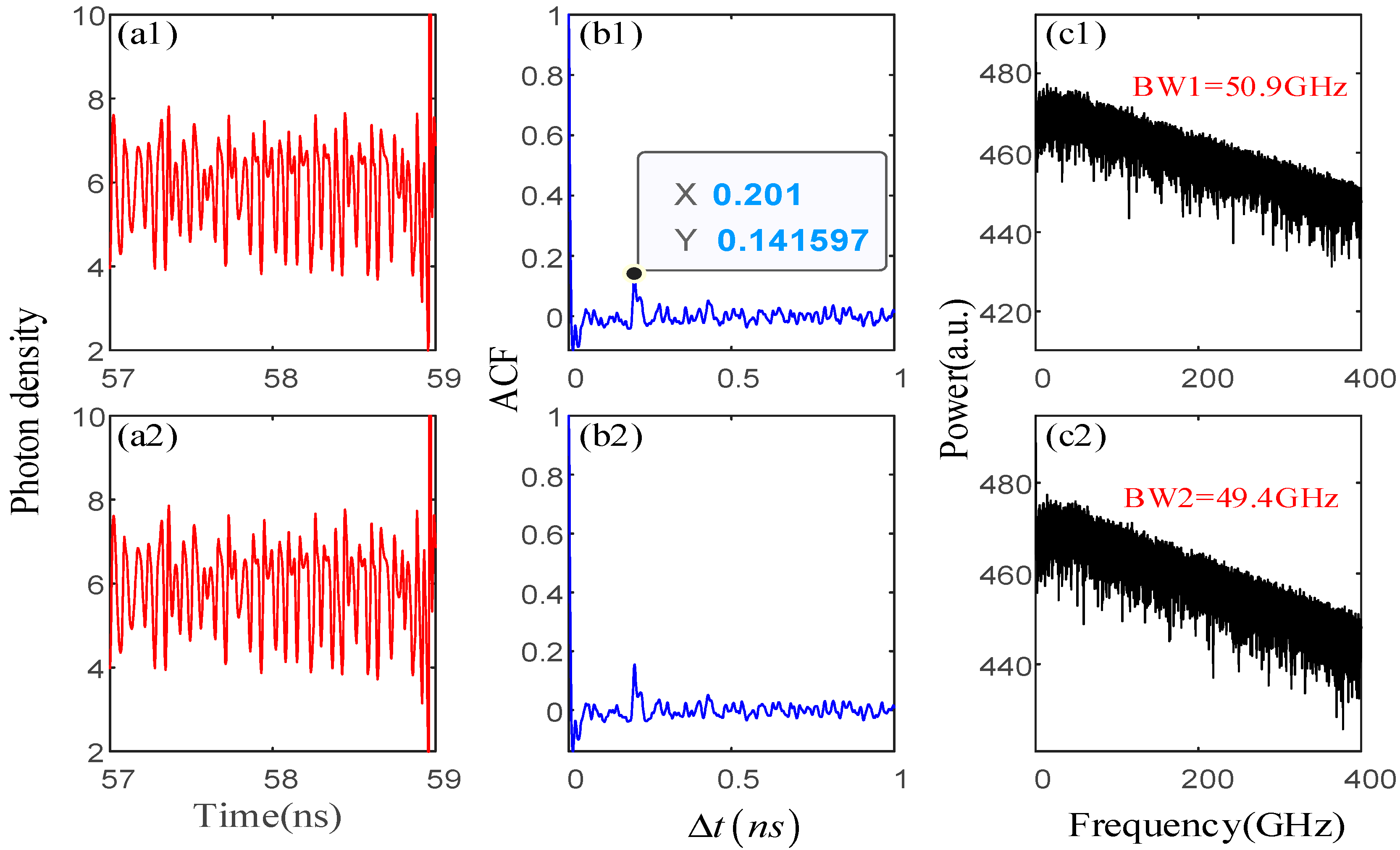
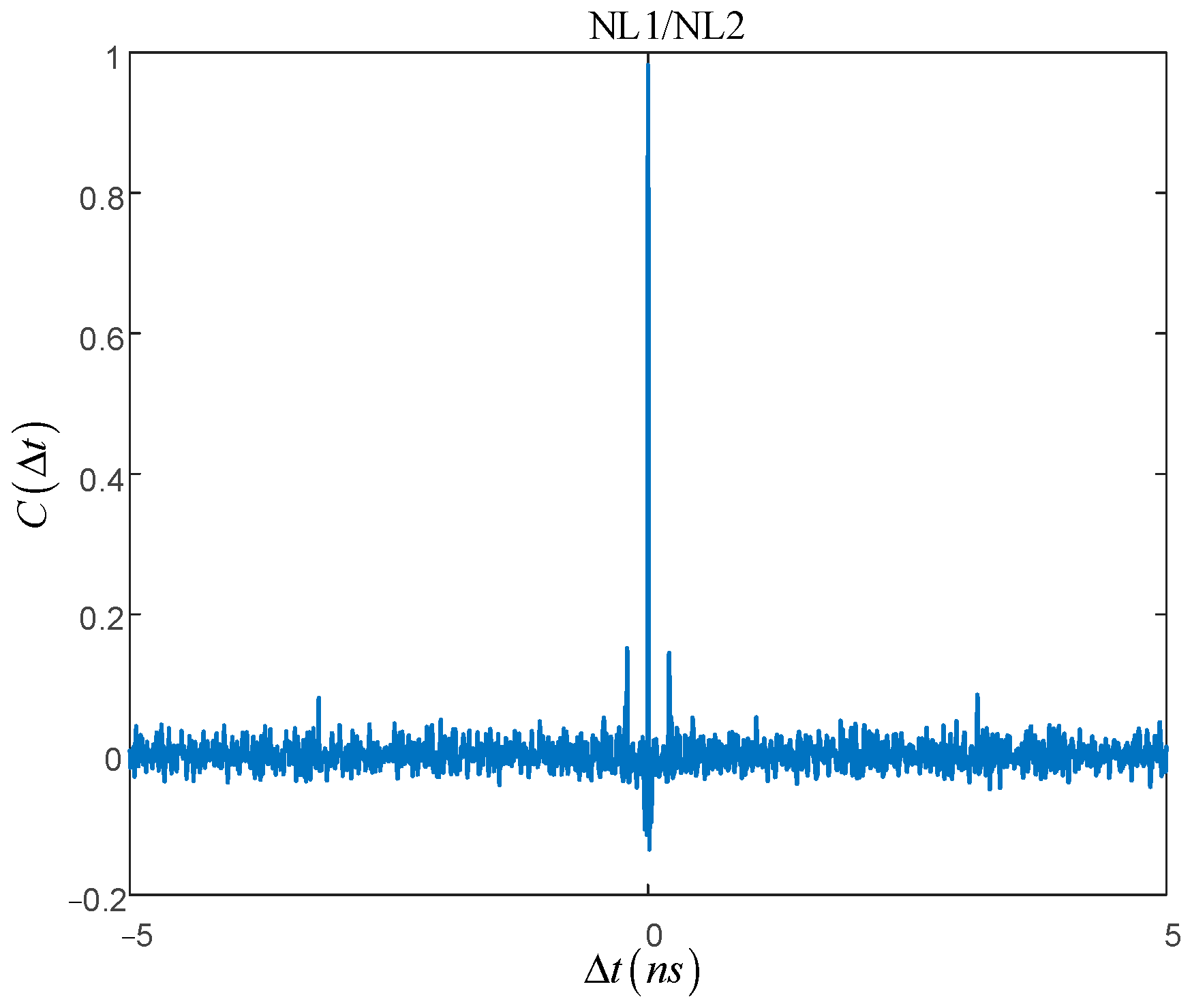
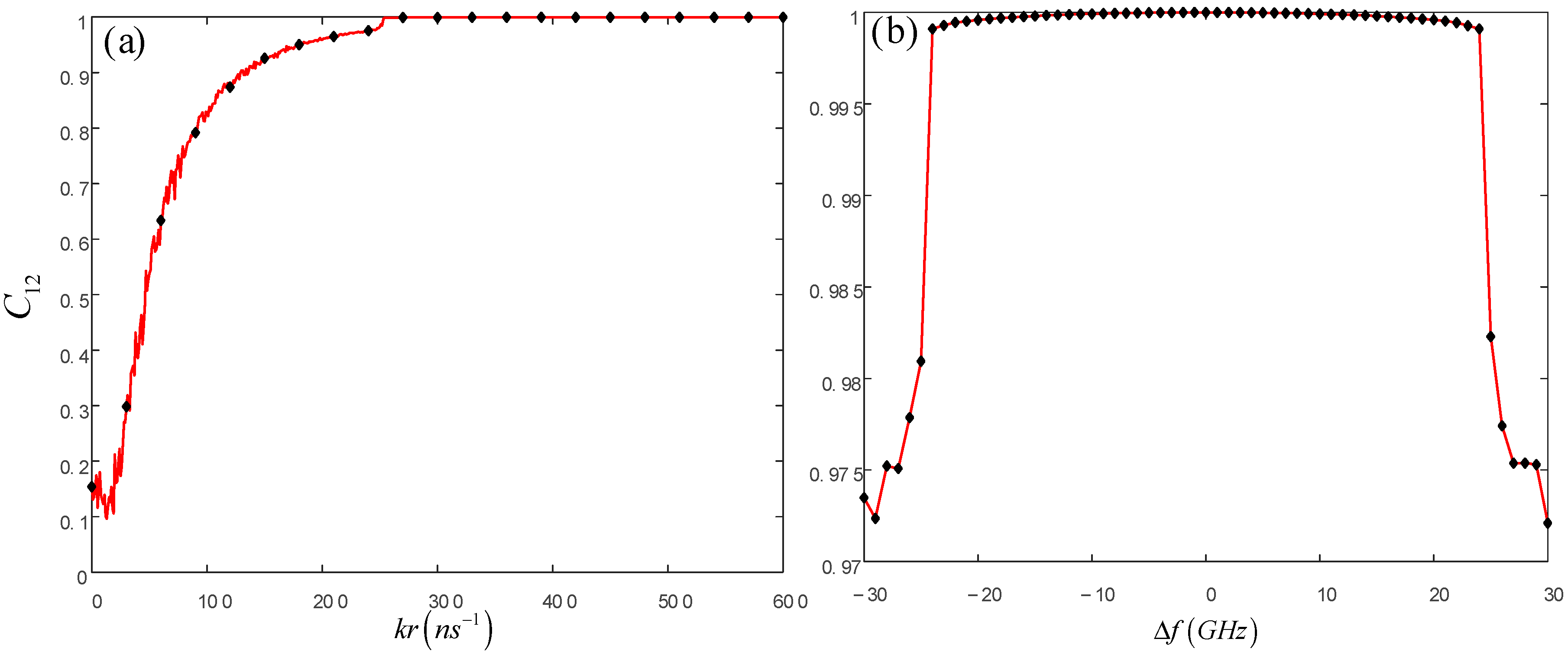
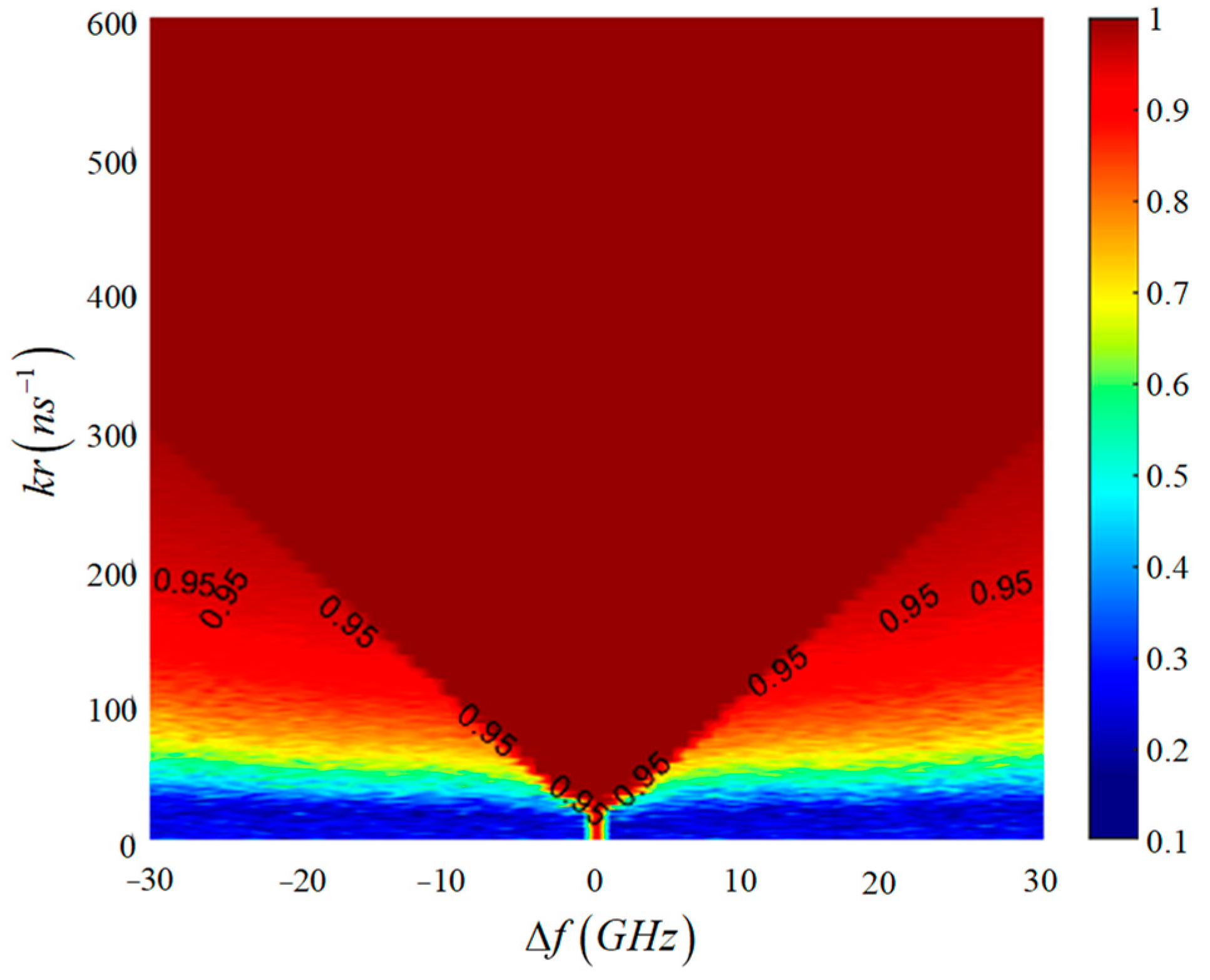
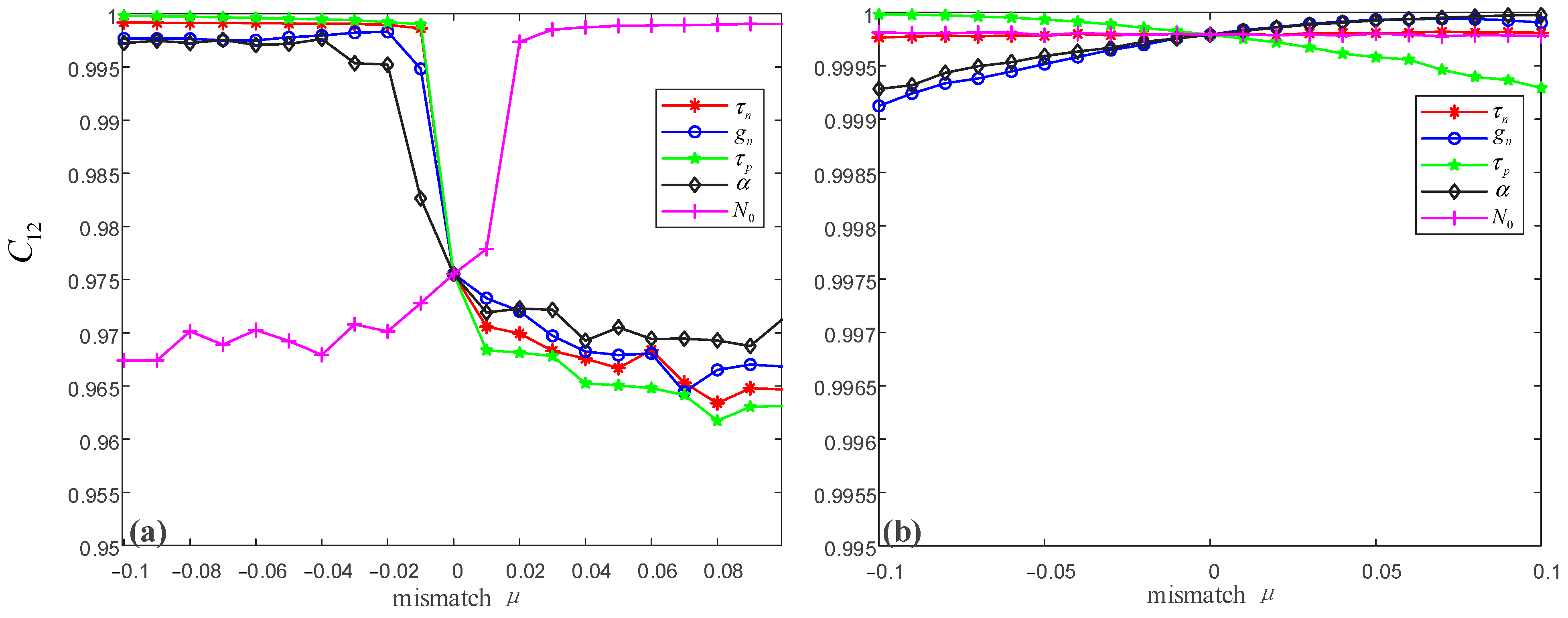
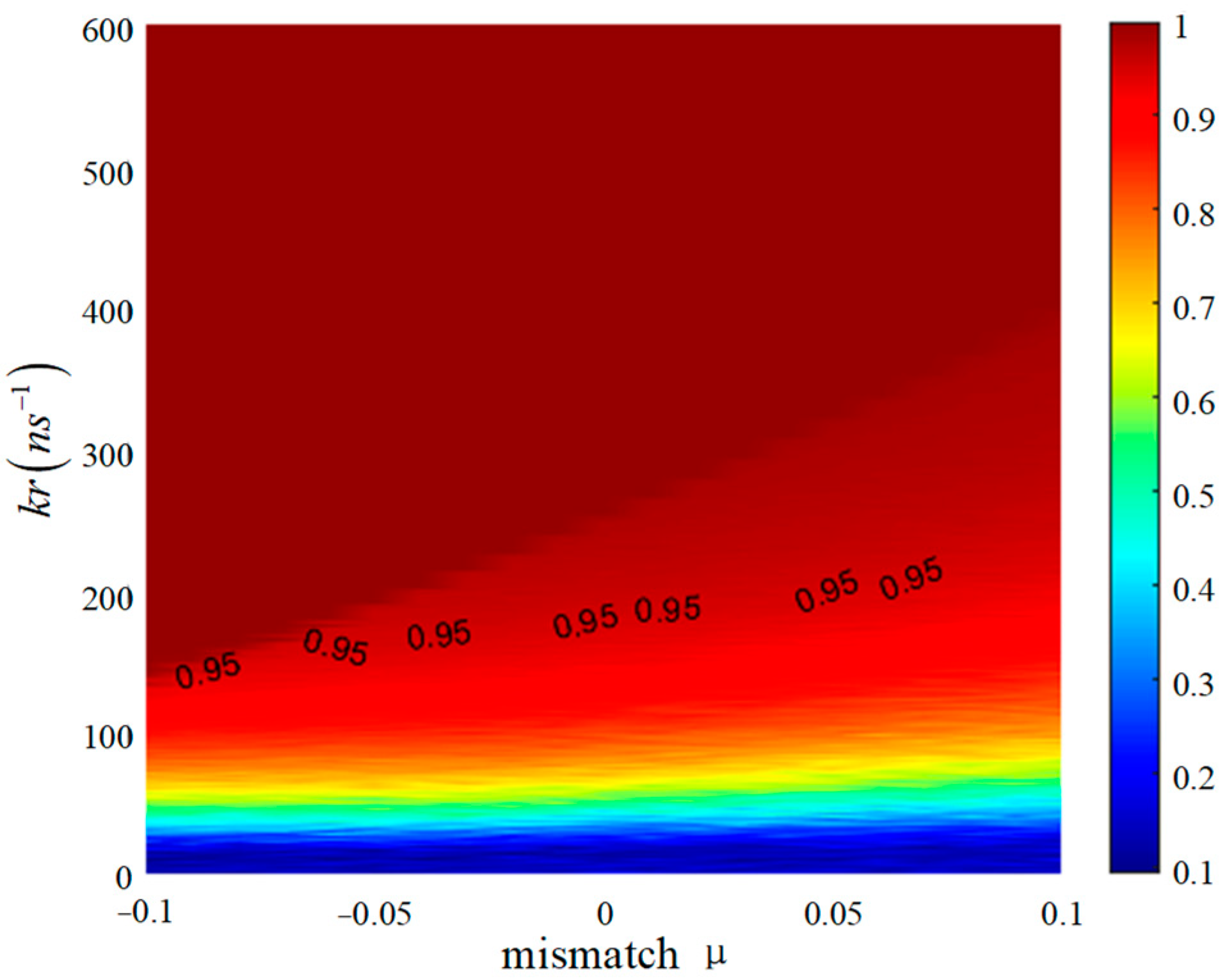
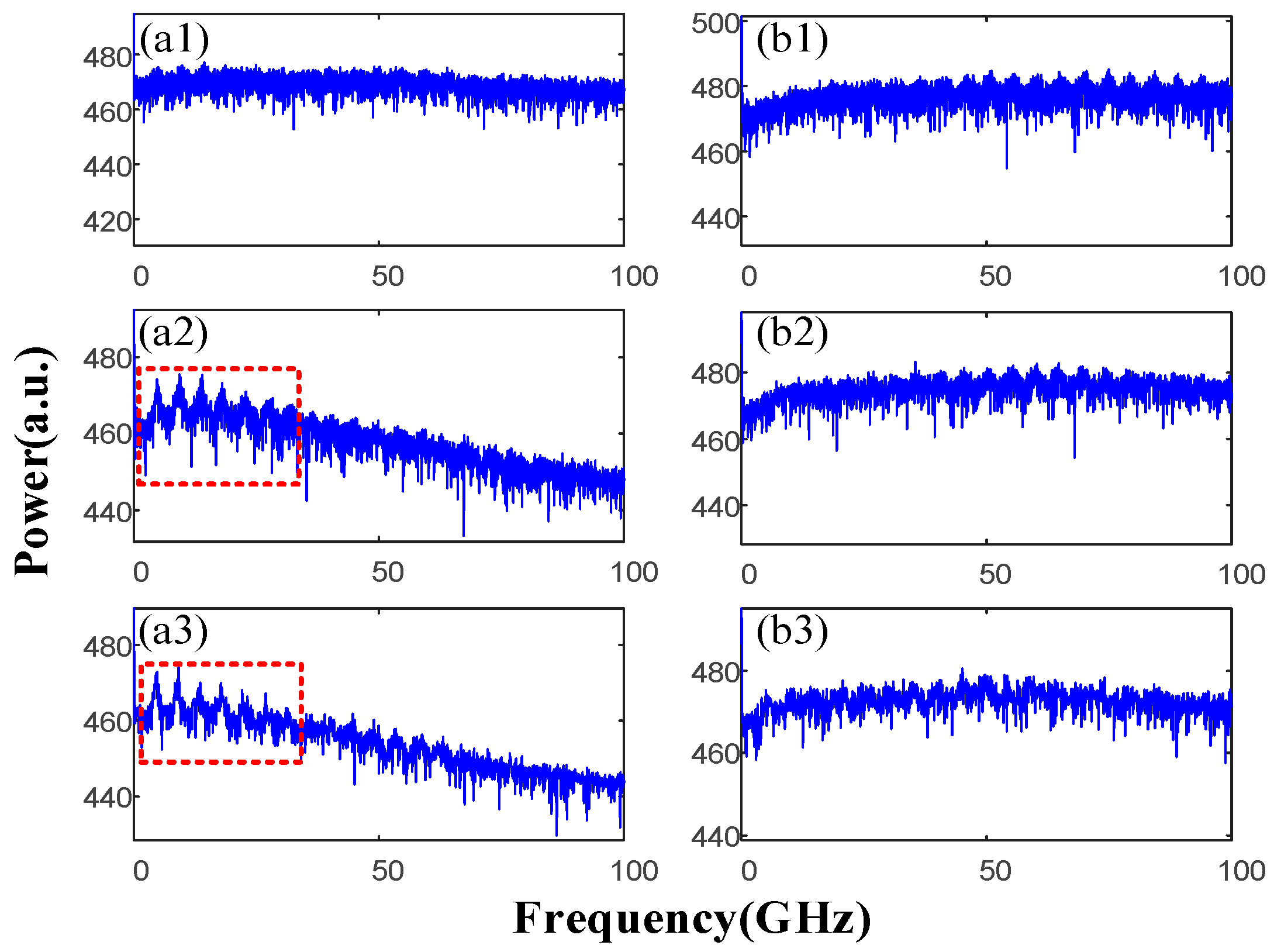

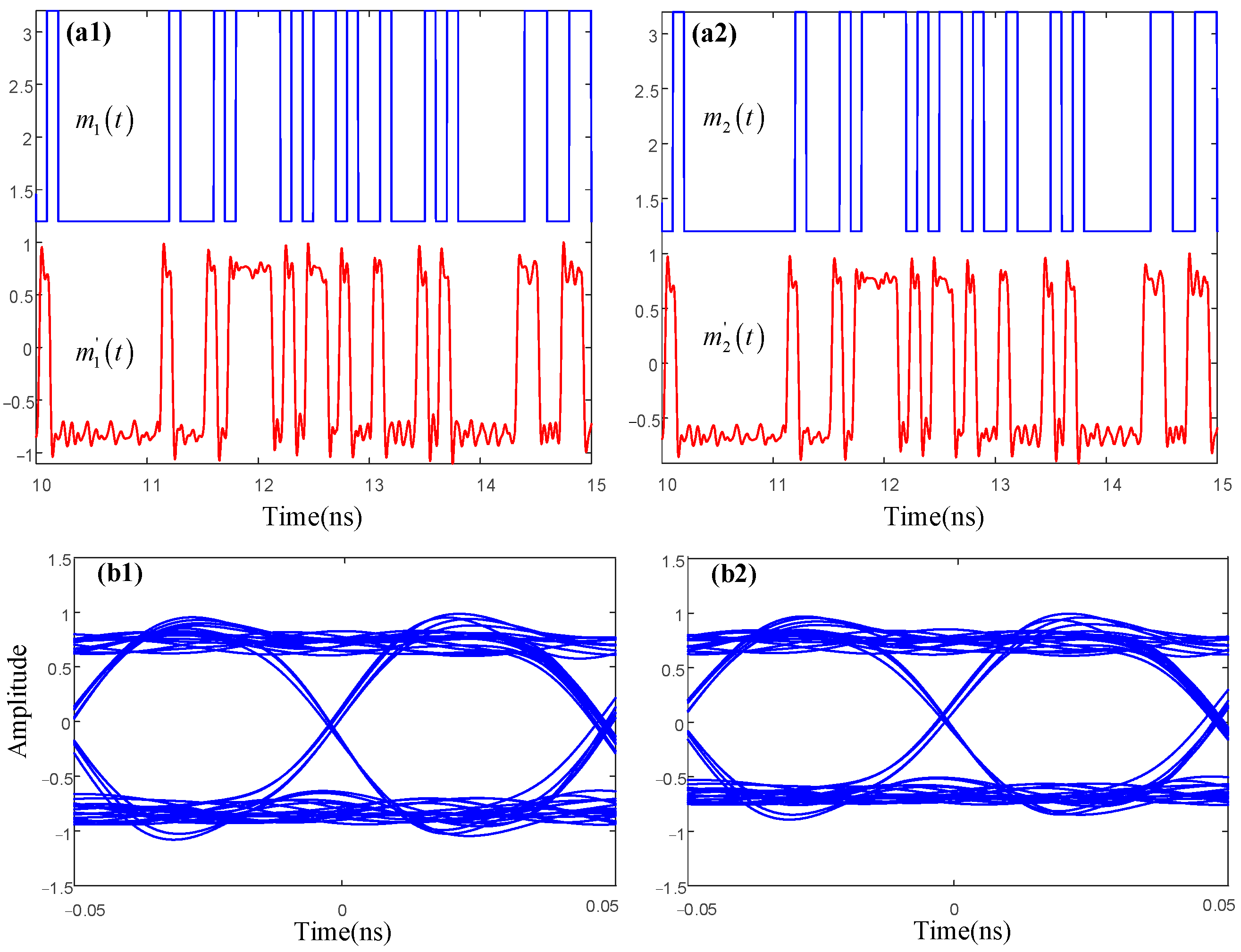

| Parameter | Description | Value |
|---|---|---|
| Confinement factor | 0.645 | |
| Carrier lifetime
Photon lifetime | 1 ns
0.36 ps | |
| td | Feedback delay | 0.2 ns |
| Differential gain | ||
| Transparency carrier density | ||
| Gain saturation factor | ||
| Linewidth enhancement factor | 5 | |
| Volume of active region | ||
| Wavelength of NL | 1591 nm | |
| Laser facet reflectivity | 0.85 | |
| External facet power reflectivity | 0.95 | |
| Injection ratio | 0–0.1 | |
| n | Refractive index | 3.4 |
| L | Cavity length | |
| Q | Quality factor | 428 |
| f | Feedback coupling fraction | 0–0.9 |
Disclaimer/Publisher’s Note: The statements, opinions and data contained in all publications are solely those of the individual author(s) and contributor(s) and not of MDPI and/or the editor(s). MDPI and/or the editor(s) disclaim responsibility for any injury to people or property resulting from any ideas, methods, instructions or products referred to in the content. |
© 2024 by the authors. Licensee MDPI, Basel, Switzerland. This article is an open access article distributed under the terms and conditions of the Creative Commons Attribution (CC BY) license (https://creativecommons.org/licenses/by/4.0/).
Share and Cite
Zhang, X.; Mu, P.; Guo, G.; Liu, X.; He, P. Bidirectional Chaotic Synchronization Communication of Closed-Loop Mutually Coupled Nano-Lasers. Electronics 2024, 13, 239. https://doi.org/10.3390/electronics13010239
Zhang X, Mu P, Guo G, Liu X, He P. Bidirectional Chaotic Synchronization Communication of Closed-Loop Mutually Coupled Nano-Lasers. Electronics. 2024; 13(1):239. https://doi.org/10.3390/electronics13010239
Chicago/Turabian StyleZhang, Xueting, Penghua Mu, Gang Guo, Xintian Liu, and Pengfei He. 2024. "Bidirectional Chaotic Synchronization Communication of Closed-Loop Mutually Coupled Nano-Lasers" Electronics 13, no. 1: 239. https://doi.org/10.3390/electronics13010239
APA StyleZhang, X., Mu, P., Guo, G., Liu, X., & He, P. (2024). Bidirectional Chaotic Synchronization Communication of Closed-Loop Mutually Coupled Nano-Lasers. Electronics, 13(1), 239. https://doi.org/10.3390/electronics13010239






